By Angus Dalton
Examine, a free weekly newsletter covering science with a sceptical, evidence-based eye, is sent every Tuesday. You’re reading an excerpt – Sign up to get the whole newsletter in your inbox.
I find it extraordinary that we share this continent with what is probably the oldest existing evidence of life ever found: stromatolites. These rocky pillars in Western Australia were built, layer by layer, by ancient cyanobacteria on an Earth so young the sky was orange, the seas were green with dissolved iron and the land was black and volcanic. These altars to early life are as old as 3.5 billion years.
So you can imagine the horror of geologist Professor Martin Van Kranendonk when he visited a stromatolite fossil outcrop in the Pilbara and found three cone-shaped stromatolites had been snapped off from their base rock and stolen.
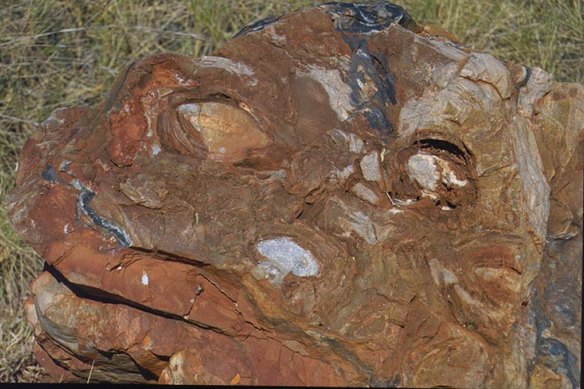
Three circular holes were conical stromatolites were snapped off.Credit: Professor Martin Van Kranendonk
“It felt like coming across a rhinoceros whose horn had been sawn off its body,” he later recalled.
And it wasn’t just looters who had inflicted damage. The first crop of stromatolite fossils ever discovered were so heavily plundered by scientists that they no longer contain evidence of early life.
Clare Fletcher, a PhD candidate at the University of NSW’s Centre for Astrobiology, studied these geological tragedies under Van Kranendonk during their master’s degree. NASA and other space agencies often visit the stromatolites because we may find similar signs of life on other planets, namely Mars.
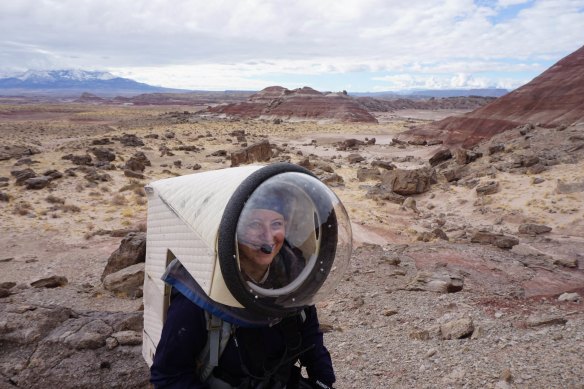
Clare Fletcher spent a month at the Mars Desert Research Station in Utah, researching for their PhD in exogeoconservation.Credit: Alexander Tobal
That got Fletcher thinking: as space agencies and private outfits fire up for the second space race, what’s the risk that we destroy evidence of alien life before we can properly study it?
Fragile evidence
“The concern is, broadly speaking, that we do to Mars what has already happened on Earth,” Fletcher says. Their PhD is focused on exogeoconservation of Mars – protecting possible evidence of life that could remain from a wetter, possibly habitable period in the planet’s history about 3.5 billion years ago (about the same time the Pilbara stromatolites were growing).
For example, in an area on Mars called Home Plate, the Spirit rover discovered silica nodules similar to structures on Earth left behind by microbes. But the entire Home Plate could be destroyed by one autonomous SpaceX rocket landing, for example, or the silica structures could be obliterated by falling debris or a crashing craft. Based on the blast radius of Elon Musk’s Starship, Fletcher has written in the Space Policy journal that an area 160 times the size of Home Plate would be damaged by lift-off from Mars.
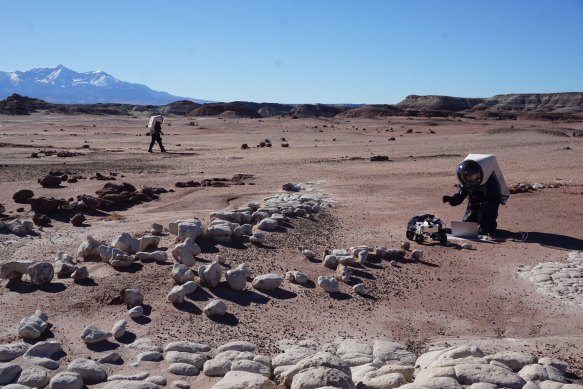
Scientists working in the Mars-like environment of Utah.Credit: Steven Hobbs
Contamination is another factor. The risks of transporting alien microbes back to Earth are obvious and controlled. But what about “forward” contamination – taking our bugs to the cosmos?
“If we bring Earth bacteria to Mars and it survives despite Mars’ very harsh conditions, how do we know if we’ve detected Martian life versus Earth life?” Fletcher asks. “That’s the biggest issue with forward contamination.”
A version of this story has already played out. Tests by the Viking landers in the ’70s came back positive for chlorinated organic compounds – evidence of potential microbial life. But the result was dismissed at the time because scientists believed the sample had been contaminated by cleaning products from Earth. It took subsequent missions to confirm the compounds were indeed Martian in nature and not stray particles of Spray ’n’ Wipe.
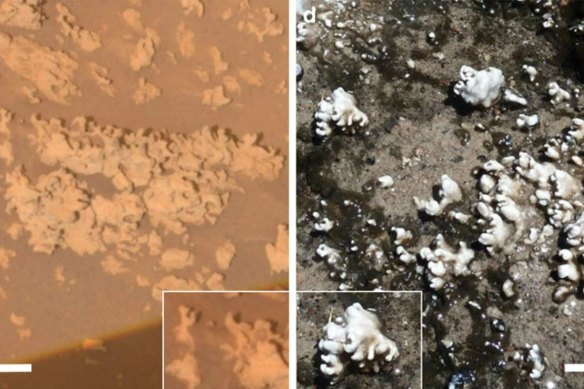
Silica structures on Mars’ Home Plate (left) compared with similar structures in Chile that are of microbial origin (right).Credit: Ruff & Farmer
Then there’s the risk of scientific oversampling. This has played out in the ancient rocks in Komati Gorge in South Africa, Fletcher says, where a geologist drilled into rocks holding clues about the conditions of early Earth an egregious 150 times in what his colleagues would brand an act of “geo-vandalism”.
Here’s the paradox at the core of Fletcher’s work: where is the line between studying a remarkable natural wonder and preserving it?
To help nail down that question, Fletcher embarked on a trip that would take them as close to Mars as they could get without a rocket ship.
Shoot for Mars and you’ll end up in Utah
Earlier this year, Fletcher spent four weeks living at the Mars Desert Research Station, a cylindrical structure nicknamed the “tin can” built in the deserts of Utah.
“It’s what’s sometimes described as badlands,” Fletcher says of the landscape. “Everything’s in these shades of red, brown, white. You get different clays that are purple and green.
“If the sky wasn’t blue, you’d really think you’re on Mars. And the site was chosen for that exact reason – it’s a geographical analogue for Mars.”
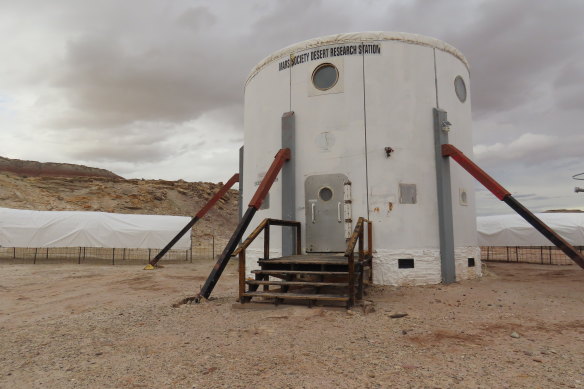
The “tin can” Mars Desert Research Station.Credit: Clare Fletcher
Scientists conduct research at the station as if they were actually on Mars, living on freeze-dried meals and strapping into mock space suits if they venture out into the desert.
Fletcher was there to test out how scientists on Mars might one day go about their work while conserving precious Martian geology. “It all went horrendously wrong for a full month,” they say. Navigating to study sites was extremely difficult. Records that were supposed to be there from NASA and the European Space Agency were missing. Weather interrupted missions. Fletcher took to making exogeoconservation calls on the fly rather than being able to rely on a rigid rule book.
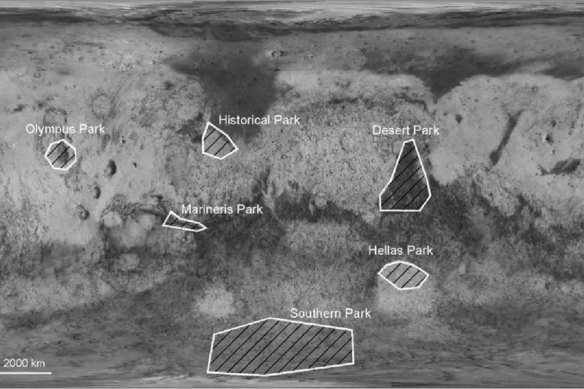
The location of proposed “planetary parks” on Mars to protect areas of space wilderness from spacecraft or scientific damage.Credit: Cockell/Horneck
The takeaway, Fletcher says, is that a will to preserve and protect sites of scientific value on other planets must be embedded in mission design. That’s why they intend to interview figures across the space industry later this year to start conversations about exogeoconservation.
“I would like it to become a norm in space exploration that geoconservation is something considered at the forefront of mission design, planning, architecture and throughout the lifespan of missions,” Fletcher says.
Many governments, including Australia, have signed up to the Committee on Space Research (COSPAR)’s Planetary Protection Policy, which implements some protections for celestial bodies. Private companies such as SpaceX, however, follow no such guidelines as they take up an increasingly active role in space exploration. Scientists for decades have been warning about the risks of private business and science pillaging planets. Some have even suggested the establishment of “planetary parks” on Mars to protect areas of space wilderness.
The stakes are high here. If we replicate our failures on Earth and damage precious geological – and even biological – sites on Mars, Fletcher says, “we risk not actually being able to learn what we’re spending tens of billions of dollars trying to learn from Mars”.
Examine, a free weekly newsletter covering science with a sceptical, evidence-based eye, is sent every Tuesday. You’re reading an excerpt – sign up to get the whole newsletter in your inbox.